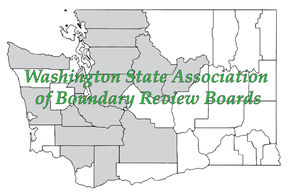A PDF version of the Planning Goals is in the Document Library here
Planning Goals of the Growth Management Act
RCW 36.70a.020
The following goals are adopted to guide the development and adoption of comprehensive plans and development regulations of those counties and cities that are required or choose to plan under RCW 36.70A.040. The following goals are not listed in order of priority and shall be used exclusively for the purpose of guiding the development of comprehensive plans and development regulations:
(1) Urban growth. Encourage development in urban areas where adequate public facilities and services exist or can be provided in an efficient manner.
(2) Reduce sprawl. Reduce the inappropriate conversion of undeveloped land into sprawling, low-density development.
(3) Transportation. Encourage efficient multimodal transportation systems that are based on regional priorities and coordinated with county and city comprehensive plans.
(4) Housing. Encourage the availability of affordable housing to all economic segments of the population of this state, promote a variety of residential densities and housing types, and encourage preservation of existing housing stock.
(5) Economic development. Encourage economic development throughout the state that is consistent with adopted comprehensive plans, promote economic opportunity for all citizens of this state, especially for unemployed and for disadvantaged persons, promote the retention and expansion of existing businesses and recruitment of new businesses, recognize regional differences impacting economic development opportunities, and encourage growth in areas experiencing insufficient economic growth, all within the capacities of the state's natural resources, public services, and public facilities.
(6) Property rights. Private property shall not be taken for public use without just compensation having been made. The property rights of landowners shall be protected from arbitrary and discriminatory actions.
(7) Permits. Applications for both state and local government permits should be processed in a timely and fair manner to ensure predictability.
(8) Natural resource industries. Maintain and enhance natural resource-based industries, including productive timber, agricultural, and fisheries industries. Encourage the conservation of productive forestlands and productive agricultural lands, and discourage incompatible uses.
(9) Open space and recreation. Retain open space, enhance recreational opportunities, conserve fish and wildlife habitat, increase access to natural resource lands and water, and develop parks and recreation facilities.
(10) Environment. Protect the environment and enhance the state's high quality of life, including air and water quality, and the availability of water.
(11) Citizen participation and coordination. Encourage the involvement of citizens in the planning process and ensure coordination between communities and jurisdictions to reconcile conflicts.
(12) Public facilities and services. Ensure that those public facilities and services necessary to support development shall be adequate to serve the development at the time the development is available for occupancy and use without decreasing current service levels below locally established minimum standards.
(13) Historic preservation. Identify and encourage the preservation of lands, sites, and structures, that have historical or archaeological significance.
[2002 c 154 § 1; 1990 1st ex.s. c 17 § 2.]
NOTES: For a 14th goal: See RCW 36.70A.480. Shorelines of the State.
RCW 36.70a.020
The following goals are adopted to guide the development and adoption of comprehensive plans and development regulations of those counties and cities that are required or choose to plan under RCW 36.70A.040. The following goals are not listed in order of priority and shall be used exclusively for the purpose of guiding the development of comprehensive plans and development regulations:
(1) Urban growth. Encourage development in urban areas where adequate public facilities and services exist or can be provided in an efficient manner.
(2) Reduce sprawl. Reduce the inappropriate conversion of undeveloped land into sprawling, low-density development.
(3) Transportation. Encourage efficient multimodal transportation systems that are based on regional priorities and coordinated with county and city comprehensive plans.
(4) Housing. Encourage the availability of affordable housing to all economic segments of the population of this state, promote a variety of residential densities and housing types, and encourage preservation of existing housing stock.
(5) Economic development. Encourage economic development throughout the state that is consistent with adopted comprehensive plans, promote economic opportunity for all citizens of this state, especially for unemployed and for disadvantaged persons, promote the retention and expansion of existing businesses and recruitment of new businesses, recognize regional differences impacting economic development opportunities, and encourage growth in areas experiencing insufficient economic growth, all within the capacities of the state's natural resources, public services, and public facilities.
(6) Property rights. Private property shall not be taken for public use without just compensation having been made. The property rights of landowners shall be protected from arbitrary and discriminatory actions.
(7) Permits. Applications for both state and local government permits should be processed in a timely and fair manner to ensure predictability.
(8) Natural resource industries. Maintain and enhance natural resource-based industries, including productive timber, agricultural, and fisheries industries. Encourage the conservation of productive forestlands and productive agricultural lands, and discourage incompatible uses.
(9) Open space and recreation. Retain open space, enhance recreational opportunities, conserve fish and wildlife habitat, increase access to natural resource lands and water, and develop parks and recreation facilities.
(10) Environment. Protect the environment and enhance the state's high quality of life, including air and water quality, and the availability of water.
(11) Citizen participation and coordination. Encourage the involvement of citizens in the planning process and ensure coordination between communities and jurisdictions to reconcile conflicts.
(12) Public facilities and services. Ensure that those public facilities and services necessary to support development shall be adequate to serve the development at the time the development is available for occupancy and use without decreasing current service levels below locally established minimum standards.
(13) Historic preservation. Identify and encourage the preservation of lands, sites, and structures, that have historical or archaeological significance.
[2002 c 154 § 1; 1990 1st ex.s. c 17 § 2.]
NOTES: For a 14th goal: See RCW 36.70A.480. Shorelines of the State.
